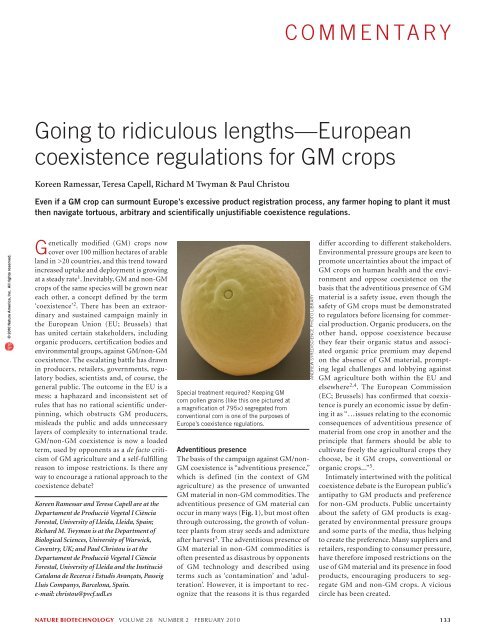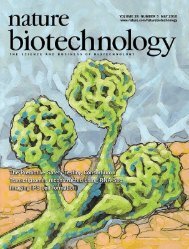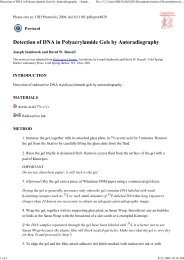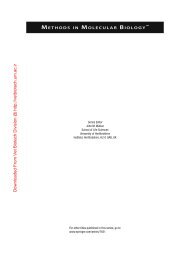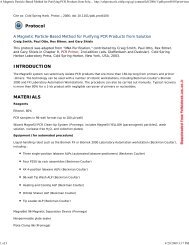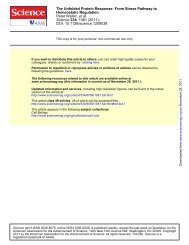case studyNever againcommentaryChristopher ScottIn 2008, Roche acquired Genentech, ending the most successful symbiotic business relationship the biotech/pharma sector has ever seen. Morphing biotech business models, pharma management’s short-termism anddwindling investor patience means we’ll never see the like of it again.© 2010 Nature America, Inc. All rights reserved.When Roche’s management acquired a $2.1 billion stake inGenentech in 1990, it eyed not only a deep pipeline of drugs,but also a team of dedicated, independent scientists. At the sametime, Roche executives also saw a financial market buzzed aboutGenentech stock. So the Swiss company bought a majority stake,with an option to buy up the rest later, and left Genentech as a standaloneunit.In 1999, the Basel-based pharma exercised that option, takingGenentech off the market for a few brief months before placing itback on the New York Stock Exchange in another public offering,taking advantage of the bullish environment. Roche then reducedits ownership by selling off shares twice more, bringing in nearly$8 billion for the three offerings (each public sale at a higher pershareprice) and Roche got to keep the majority of product revenueevery year, as a primary stakeholder.By all accounts, this relationship was mutually beneficial. Thepharma’s stake in Genentech was essentially a gift that kept on giving.For its part, Genentech retained product marketing rights inside theUnited States and was able to foster its science in a ‘small company’culture free from interference by its Swiss partner.But Roche couldn’t resist taking the final bite: in March last yearthe pharma acquired the remaining 44% stake it didn’t already ownin a $46.8 billion deal. Analysts fretted that the entrepreneurial culturewould yield to a staid Swiss lockstep. Even Roche chairmanFranz Humer, who drove the deal, had previously said that a buyoutwould “never work, because if we owned all of Genentech we wouldkill it.”In market share alone, Roche-Genentech is now the seventh largestUS pharmaceutical company, projected to generate $17 billion inrevenue yearly. In the months since the merger, Roche pulled out ofthe Washington, DC, lobbying group Pharmaceutical Research andManufacturers of America, saying it would work instead through thebiotech equivalent, the Washington, DC–based Biotechnology IndustryOrganization. And the June American Society of Clinical Oncologymeeting was chock-full of rosy reports from Roche-Genentech’s growingoncology portfolio, with ten new molecular entities in clinical development.In August, the US Food and Drug Administration approvedAvastin (bevacizumab) for kidney cancer. New uses for establisheddrugs, such as Tarceva (erlotinib), Lucentis (ranibizumab) and Avastin,are also moving through confirmatory trials.The union produced its share of changes in senior management.Founder Arthur Levinson moved up to the board of directors andthe president of product development, Susan Desmond-Hellmann,departed. Sandra Horning, a longtime Stanford academic with nopharma experience, took over as senior vice president of global clinicaldevelopment. The chief of operations, Richard Scheller, and his toplieutenants stayed. Time will tell whether the new structure can sustainthe track record of the independent biotech, but even before thebuyout, Genentech’s business had become more reliant on extensionsChristopher Scott is Contributing Editor at Nature Biotechnology.of its existing product franchise (similar to any other big company)rather than production of new therapeutic entities.Few pharma-biotech relationships look anything like the Roche-Genentech courtship. Consider Johnson & Johnson (J&J) of NewBrunswick, New Jersey, locking up Centocor for $4.9 billion in 1999.Centocor was another biotech with an early blockbuster and goodscience to back it up. But J&J treated it like any other merger; thoughit left the biotech as a stand-alone unit, the latter was not publicand had no scientific autonomy. In 2008, J&J merged Centocor withOrtho Biotech, slashed 400 jobs at Ortho and deployed the remainingresources to support Centocor’s high-selling anti-tumor necrosisfactor alpha compound Remicade (infliximab). Today, J&J partiallyowes its standing as a leading drug maker to Remicade: in 2008, ithad worldwide revenue of $5.3 billion. That’s a big hitter in J&J’slineup, but it has made Centocor look an awful lot like a one-trickpony. Genentech, it was not.More diversifying was Basel-based Novartis’ purchase of Emeryville,California–based Chiron for $5.1 billion in 2006. Here again, unlikeRoche’s hands-off approach with Genentech, the acquisition immediatelysent executives from the biotech packing and put scientistsand their projects on the bubble. That year, Novartis launched athree-year reorganization plan, and Chiron went inside Novartis’vaccine and diagnostics division, which last year accounted for just4% of its $42.6 billion in sales. Though Chiron’s vaccine expertise hasbeen important in developing chicken egg–free flu vaccine productionmethods, Novartis did not buy Chiron to play parent; it boughtit to hoard the valuables.Is there another young Genentech and nurturing pharma parentstill out there? Staring across today’s biotech landscape (economicdownturn or not), the answer seems to be no. Another Genentechwould need not only to have a promising and established pipeline,but also to be surrounded by a free-wheeling scientific culture. Thatis awfully hard to find these days, in part because biotech companiesare no longer built with flexible business plans designed to chase bigquestions down dark alleys, as Genentech was.Firms are designed for a quick and total buyout and a return onventure money. Any burgeoning Genentech wannabe would becherry-picked long before its first product launch. What’s more,once consummated, big mergers today tend to isolate resources forthe probable winning compounds, leaving the rest of the science towither on the vine. The priorities for today’s top management aremore myopic: how does an acquisition and its compounds affect thebalance sheet; science is secondary.One final reason that Genentech-Roche is a once-in-a-lifetimerelationship: luck. Though Genentech was a clear biotech leader in1990, and its vaunted pipeline has long been discussed as one of theindustry’s best, the business of making drugs is scored by failure andserendipity alike. It took the financial stability of Roche, the geniusof Genentech’s scientists, an inspiring intellectual culture and providenceto spin out product after product. But lightning does notstrike twice.nature biotechnology volume 28 number 2 february 2010 131
commentaryGoing to ridiculous lengths—Europeancoexistence regulations for GM cropsKoreen Ramessar, Teresa Capell, Richard M Twyman & Paul ChristouEven if a GM crop can surmount Europe’s excessive product registration process, any farmer hoping to plant it mustthen navigate tortuous, arbitrary and scientifically unjustifiable coexistence regulations.© 2010 Nature America, Inc. All rights reserved.Genetically modified (GM) crops nowcover over 100 million hectares of arableland in >20 countries, and this trend towardincreased uptake and deployment is growingat a steady rate 1 . Inevitably, GM and non-GMcrops of the same species will be grown neareach other, a concept defined by the term‘coexistence’ 2 . There has been an extraordinaryand sustained campaign mainly inthe European Union (EU; Brussels) thathas united certain stakeholders, includingorganic producers, certification bodies andenvironmental groups, against GM/non-GMcoexistence. The escalating battle has drawnin producers, retailers, governments, regulatorybodies, scientists and, of course, thegeneral public. The outcome in the EU is amess: a haphazard and inconsistent set ofrules that has no rational scientific underpinning,which obstructs GM producers,misleads the public and adds unnecessarylayers of complexity to international trade.GM/non-GM coexistence is now a loadedterm, used by opponents as a de facto criticismof GM agriculture and a self-fulfillingreason to impose restrictions. Is there anyway to encourage a rational approach to thecoexistence debate?Koreen Ramessar and Teresa Capell are at theDepartament de Producció Vegetal I CiènciaForestal, University of Lleida, Lleida, Spain;Richard M. Twyman is at the Department ofBiological Sciences, University of Warwick,Coventry, UK; and Paul Christou is at theDepartament de Producció Vegetal I CiènciaForestal, University of Lleida and the InstitucióCatalana de Recerca i Estudis Avançats, PasseigLluís Companys, Barcelona, Spain.e-mail: christou@pvcf.udl.esSpecial treatment required? Keeping GMcorn pollen grains (like this one pictured ata magnification of 795×) segregated fromconventional corn is one of the purposes ofEurope’s coexistence regulations.Adventitious presenceThe basis of the campaign against GM/non-GM coexistence is “adventitious presence,”which is defined (in the context of GMagriculture) as the presence of unwantedGM material in non-GM commodities. Theadventitious presence of GM material canoccur in many ways (Fig. 1), but most oftenthrough outcrossing, the growth of volunteerplants from stray seeds and admixtureafter harvest 3 . The adventitious presence ofGM material in non-GM commodities isoften presented as disastrous by opponentsof GM technology and described usingterms such as ‘contamination’ and ‘adulteration’.However, it is important to recognizethat the reasons it is thus regardedANDREW SYRED/SCIENCE PHOTO LIBRARYdiffer according to different stakeholders.Environmental pressure groups are keen topromote uncertainties about the impact ofGM crops on human health and the environmentand oppose coexistence on thebasis that the adventitious presence of GMmaterial is a safety issue, even though thesafety of GM crops must be demonstratedto regulators before licensing for commercialproduction. Organic producers, on theother hand, oppose coexistence becausethey fear their organic status and associatedorganic price premium may dependon the absence of GM material, promptinglegal challenges and lobbying againstGM agriculture both within the EU andelsewhere 2,4 . The European Commission(EC; Brussels) has confirmed that coexistenceis purely an economic issue by definingit as “…issues relating to the economicconsequences of adventitious presence ofmaterial from one crop in another and theprinciple that farmers should be able tocultivate freely the agricultural crops theychoose, be it GM crops, conventional ororganic crops...” 5 .Intimately intertwined with the politicalcoexistence debate is the European public’santipathy to GM products and preferencefor non-GM products. Public uncertaintyabout the safety of GM products is exaggeratedby environmental pressure groupsand some parts of the media, thus helpingto create the preference. Many suppliers andretailers, responding to consumer pressure,have therefore imposed restrictions on theuse of GM material and its presence in foodproducts, encouraging producers to segregateGM and non-GM crops. A viciouscircle has been created.nature biotechnology volume 28 number 2 february 2010 133
- Page 3 and 4: volume 28 number 2 february 2010COM
- Page 5 and 6: in this issue© 2010 Nature America
- Page 7 and 8: © 2010 Nature America, Inc. All ri
- Page 10 and 11: NEWS© 2010 Nature America, Inc. Al
- Page 12 and 13: NEWS© 2010 Nature America, Inc. Al
- Page 14 and 15: NEWS© 2010 Nature America, Inc. Al
- Page 16 and 17: © 2010 Nature America, Inc. All ri
- Page 18 and 19: © 2010 Nature America, Inc. All ri
- Page 20 and 21: © 2010 Nature America, Inc. All ri
- Page 22 and 23: NEWS feature© 2010 Nature America,
- Page 24 and 25: uilding a businessComing to termsDa
- Page 26 and 27: uilding a business© 2010 Nature Am
- Page 28 and 29: correspondence© 2010 Nature Americ
- Page 30 and 31: correspondence© 2010 Nature Americ
- Page 32 and 33: correspondence© 2010 Nature Americ
- Page 34 and 35: correspondence© 2010 Nature Americ
- Page 38 and 39: COMMENTARY© 2010 Nature America, I
- Page 40 and 41: COMMENTARY© 2010 Nature America, I
- Page 42 and 43: patents© 2010 Nature America, Inc.
- Page 44 and 45: patents© 2010 Nature America, Inc.
- Page 46 and 47: news and viewsChIPs and regulatory
- Page 48 and 49: news and viewsFrom genomics to crop
- Page 50 and 51: news and views© 2010 Nature Americ
- Page 52 and 53: news and views© 2010 Nature Americ
- Page 54 and 55: e s o u r c eRational association o
- Page 56 and 57: e s o u r c e© 2010 Nature America
- Page 58 and 59: e s o u r c e© 2010 Nature America
- Page 60 and 61: e s o u r c e© 2010 Nature America
- Page 62 and 63: © 2010 Nature America, Inc. All ri
- Page 64 and 65: B r i e f c o m m u n i c at i o n
- Page 66 and 67: i e f c o m m u n i c at i o n sAUT
- Page 68 and 69: lettersa1.5 kb hVPrIntron 112.5 kbA
- Page 70 and 71: letters© 2010 Nature America, Inc.
- Page 72 and 73: letters© 2010 Nature America, Inc.
- Page 74 and 75: l e t t e r sReal-time imaging of h
- Page 76 and 77: l e t t e r sFigure 2 Time-lapse li
- Page 78 and 79: l e t t e r s© 2010 Nature America
- Page 80 and 81: l e t t e r sRational design of cat
- Page 82 and 83: l e t t e r s© 2010 Nature America
- Page 84 and 85: l e t t e r s© 2010 Nature America
- Page 86 and 87:
sample fluorescence was measured as
- Page 88 and 89:
careers and recruitmentFourth quart


